
K-box was a small loudspeaker powered by an internal amplifier sold by Kerchoonz.com in 2009.

K-box was a small loudspeaker powered by an internal amplifier sold by Kerchoonz.com in 2009.
When placed onto solid flat surfaces, walls or windows the K-box turns the surface into speakers or sound board. [1] It amplifies and provide stereo sound that is supplied by any audio source that has 3.5mm audio output. The K-box can be utilized with contemporary electronics, like a computer, iPod, iPhone, television, or portable gaming device. The K-box is about the size of a standard cell (mobile) phone. [2] The K-box uses a hybrid technology of standard speaker, delivering mid to high frequencies and a Gel Audio driver (developed by SFX Technologies) [3] delivering low end Bass frequencies. When placed on flat solid surfaces, this technology enhances the bass response via high-intensity vibrations. [4] in order to generate sound and thus improve the volume and audio quality. [5] The K-box gel audio technology has been explained as “hydro-gel” suspension system used to improve the dynamics in comparison to similar speaker products which typically work on transduction. [6]
The K-box is powered by a built-in rechargeable battery with claims of 20 hours of playtime per charge It is recharged via computer USB or 5v adaptor. [7]
STV's Colin Kelly "Gadget Guru" presenter for the television program "The Hour" mentions K-box in his television review as among the best sounds from one of these "boombox" products for taking to the beach. According to the show, the product is made in Scotland. [8]
Portable (115 x 55 x 20mm) Up to 20 hours battery life (recharge via USB) [5] Maximum spl is 95 Db, [6] depending on location and surface on which it is placed It has a given frequency response of 40H-20 kHz [9]
The K-box received an award as runner-up as The Most Valuable Music Therapy Product of 2009 by The Therapy Times in July 2009. [10]
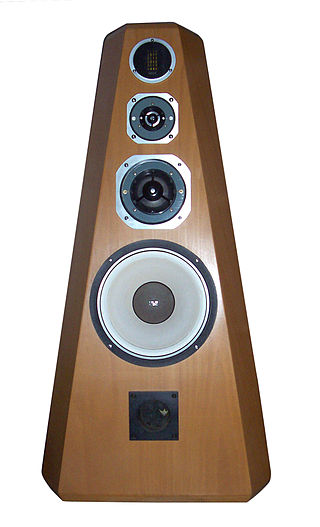
High fidelity is the high-quality reproduction of sound. It is popular with audiophiles and home audio enthusiasts. Ideally, high-fidelity equipment has inaudible noise and distortion, and a flat frequency response within the human hearing range.

A subwoofer is a loudspeaker designed to reproduce low-pitched audio frequencies, known as bass and sub-bass, that are lower in frequency than those which can be (optimally) generated by a woofer. The typical frequency range that is covered by a subwoofer is about 20–200 Hz for consumer products, below 100 Hz for professional live sound, and below 80 Hz in THX-certified systems. Thus, one or more subwoofers are important for high-quality sound reproduction as they are responsible for the lowest two to three octaves of the ten octaves that are audible. This very low-frequency (VLF) range reproduces the natural fundamental tones of the bass drum, electric bass, double bass, grand piano, contrabassoon, tuba, in addition to thunder, gunshots, explosions, etc.

A loudspeaker is an electroacoustic transducer that converts an electrical audio signal into a corresponding sound. A speaker system, also often simply referred to as a speaker or loudspeaker, comprises one or more such speaker drivers, an enclosure, and electrical connections possibly including a crossover network. The speaker driver can be viewed as a linear motor attached to a diaphragm which couples that motor's movement to motion of air, that is, sound. An audio signal, typically from a microphone, recording, or radio broadcast, is amplified electronically to a power level capable of driving that motor in order to reproduce the sound corresponding to the original unamplified electronic signal. This is thus the opposite function to the microphone; indeed the dynamic speaker driver, by far the most common type, is a linear motor in the same basic configuration as the dynamic microphone which uses such a motor in reverse, as a generator.
An audiophile is a person who is enthusiastic about high-fidelity sound reproduction. An audiophile seeks to reproduce recorded music to achieve high sound quality, typically in a quiet listening space and in a room with good acoustics.

Headphones are a pair of small loudspeaker drivers worn on or around the head over a user's ears. They are electroacoustic transducers, which convert an electrical signal to a corresponding sound. Headphones let a single user listen to an audio source privately, in contrast to a loudspeaker, which emits sound into the open air for anyone nearby to hear. Headphones are also known as earphones or, colloquially, cans. Circumaural and supra-aural headphones use a band over the top of the head to hold the drivers in place. Another type, known as earbuds or earpieces, consists of individual units that plug into the user's ear canal. A third type are bone conduction headphones, which typically wrap around the back of the head and rest in front of the ear canal, leaving the ear canal open. In the context of telecommunication, a headset is a combination of a headphone and microphone.

A horn loudspeaker is a loudspeaker or loudspeaker element which uses an acoustic horn to increase the overall efficiency of the driving element(s). A common form (right) consists of a compression driver which produces sound waves with a small metal diaphragm vibrated by an electromagnet, attached to a horn, a flaring duct to conduct the sound waves to the open air. Another type is a woofer driver mounted in a loudspeaker enclosure which is divided by internal partitions to form a zigzag flaring duct which functions as a horn; this type is called a folded horn speaker. The horn serves to improve the coupling efficiency between the speaker driver and the air. The horn can be thought of as an "acoustic transformer" that provides impedance matching between the relatively dense diaphragm material and the less-dense air. The result is greater acoustic output power from a given driver.
Klipsch Audio Technologies is an American loudspeaker company based in Indianapolis, Indiana. Founded in Hope, Arkansas, in 1946 as 'Klipsch and Associates' by Paul W. Klipsch, the company produces loudspeaker drivers and enclosures, as well as complete loudspeakers for high-end, high-fidelity sound systems, public address applications, and personal computers.
Altec Lansing, Inc. is an American audio electronics company founded in 1927. Their primary products are loudspeakers and associated audio electronics for professional, home, automotive and multimedia applications.
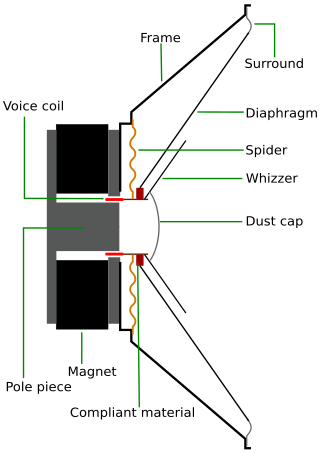
A full-range loudspeaker drive unit is defined as a driver which reproduces as much of the audible frequency range as possible, within the limitations imposed by the physical constraints of a specific design. The frequency range of these drivers is maximized through the use of a whizzer cone and other means. Most single driver systems, such as those in radios, or small computer speaker designs, cannot reproduce all of the audible frequencies or the entire audible audio range.
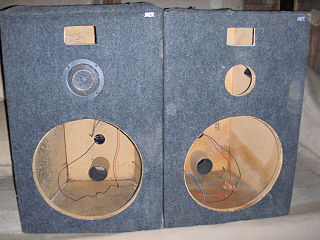
A loudspeaker enclosure or loudspeaker cabinet is an enclosure in which speaker drivers and associated electronic hardware, such as crossover circuits and, in some cases, power amplifiers, are mounted. Enclosures may range in design from simple, homemade DIY rectangular particleboard boxes to very complex, expensive computer-designed hi-fi cabinets that incorporate composite materials, internal baffles, horns, bass reflex ports and acoustic insulation. Loudspeaker enclosures range in size from small "bookshelf" speaker cabinets with 4-inch (10 cm) woofers and small tweeters designed for listening to music with a hi-fi system in a private home to huge, heavy subwoofer enclosures with multiple 18-inch (46 cm) or even 21-inch (53 cm) speakers in huge enclosures which are designed for use in stadium concert sound reinforcement systems for rock music concerts.
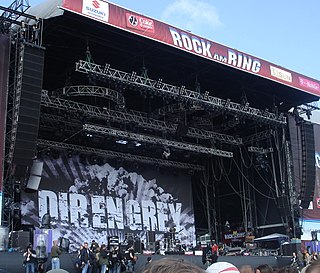
A line array is a loudspeaker system that is made up of a number of usually identical loudspeaker elements mounted in a line and fed in phase, to create a near-line source of sound. The distance between adjacent drivers is close enough that they constructively interfere with each other to send sound waves farther than traditional horn-loaded loudspeakers, and with a more evenly distributed sound output pattern.
SpeakerCraft is an American manufacturer of custom-installed audio/video and home theater products based in Petaluma, California.

A headset is a combination of headphone and microphone. Headsets connect over a telephone or to a computer, allowing the user to speak and listen while keeping both hands free. They are commonly used in customer service and technical support centers, where employees can converse with customers while typing information into a computer. They are also common among computer gamers and let them talk with each other and hear others while using their keyboards and mice to play the game.

Wireless speakers are loudspeakers that receive audio signals using radio frequency (RF) waves rather than over audio cables. The two most popular RF frequencies that support audio transmission to wireless loudspeakers include a variation of WiFi IEEE 802.11, while others depend on Bluetooth to transmit audio data to the receiving speaker.
Distributed Mode Loudspeaker (DML) is a flat panel loudspeaker technology, developed by NXT, in which sound is produced by inducing uniformly distributed vibration modes in the panel through a special electro-acoustic exciter. Distributed mode loudspeakers function differently from most others, which typically produce sound by inducing pistonic motion in the diaphragm.
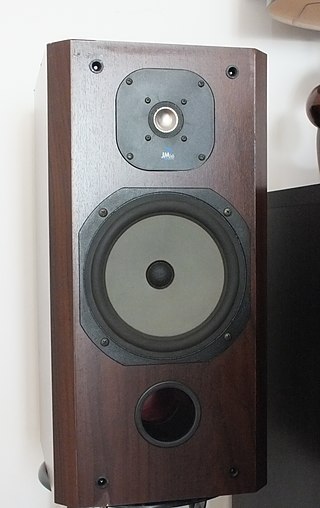
Focal-JMlab is a French company that has designing and selling high fidelity audio systems since 1979. Based in Saint-Étienne, the company manufactures loudspeakers for the home, speaker drivers for automobiles, headphones, and professional monitor loudspeakers.

The Quad Electrostatic Loudspeaker (ESL) is the world's first production full-range electrostatic loudspeaker, launched in 1957 by Quad Electroacoustics, then known as the Acoustical Manufacturing Co. Ltd. The speaker is shaped somewhat like a home electric radiator curved slightly on the vertical axis. They are widely admired for their clarity and precision, but known to be difficult speakers to run and maintain.
Sound Blaster Roar is a portable Bluetooth speaker manufactured by Creative Technology Ltd. The speaker was launched on 27 February 2014 at the IT Show 2014 in Singapore. It has got two amplifiers one for driving the low and medium frequency and the other for high frequency. There are five drivers in the speaker, one 2.5" woofer, two passive radiators and two front 1.5” high frequency drivers.

K-array is an Italy-based manufacturer of loudspeakers and amplification products for the professional audio market. K-array’s products are sold in over 50 countries around the world, and have been used in a variety of environments including major concert tours, cathedrals, stadia, theatres, restaurants and hotels.